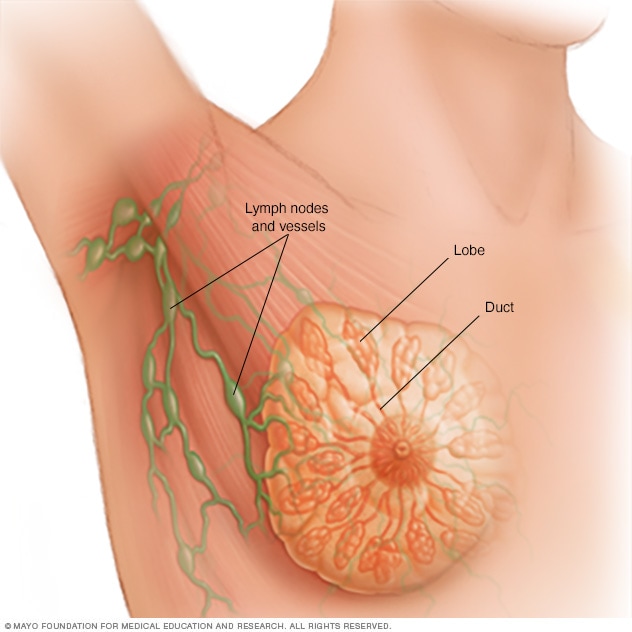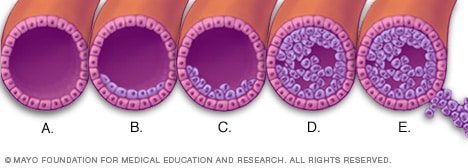Overview
Breast anatomy

Breast anatomy
Each breast contains 15 to 20 lobes of glandular tissue, arranged like the petals of a daisy. The lobes are further divided into smaller lobules that produce milk for breastfeeding. Small tubes, called ducts, conduct the milk to a reservoir that lies just beneath your nipple.
Atypical hyperplasia of the breast is the development of precancerous cells in the breast. Atypical hyperplasia causes a buildup of cells in the breast tissue. When viewed with a microscope, the cells look different from typical breast cells.
Atypical hyperplasia of the breast isn't breast cancer. But it's a sign that you have an increased risk of breast cancer in the future.
Your healthcare team creates a plan to help you manage your risk of breast cancer. Often this includes more-frequent breast cancer screening tests. You also might consider medicines to reduce breast cancer risk.
Products & Services
Symptoms
Atypical hyperplasia of the breast usually doesn't cause any symptoms.
Atypical hyperplasia of the breast is typically found during a breast biopsy. A breast biopsy is a procedure to remove some breast cells for testing. It's often recommended if something concerning is found on a mammogram or an ultrasound. A biopsy also might be done to investigate a breast concern, such as a lump.
When to see a doctor
Make an appointment with a doctor or other healthcare professional if you have any symptoms that worry you.
Causes
How breast cancer develops

How breast cancer develops
Ductal breast cancer is thought to begin with a growth of cells in a breast duct. A. A typical breast duct is shown. B. An overgrowth of cells may develop in the breast duct. This is called hyperplasia. C. Over time, the cells develop changes that make them look different from typical cells. This is called atypical hyperplasia. D. The atypical cells may continue to build up. The cells are trapped in the breast duct. This is called ductal carcinoma in situ. E. Eventually the cancer cells may break out of the duct and become invasive breast cancer. The cells can spread to other parts of the body.
It's not clear what causes atypical hyperplasia of the breast.
Atypical hyperplasia of the breast happens when cells in the breast tissue develop changes in their DNA. A cell's DNA holds the instructions that tell the cell what to do. The changes tell the cell to make many more cells. This causes a buildup of cells in the breast. Healthcare professionals call this buildup hyperplasia. The changes also turn the cells into atypical cells. This means that the cells look different from typical cells.
Atypical hyperplasia is thought to be a very early step in the process that turns healthy cells into cancer cells. In theory, if atypical hyperplasia cells are allowed to continue growing, they could get more DNA changes and become cancer cells. More research is needed to understand how this happens.
Atypical hyperplasia can happen in the breast ducts or the breast lobules:
- Atypical ductal hyperplasia describes a growth of atypical cells within the breast ducts. The breast ducts are tubes that can carry breast milk to the nipple. This type of atypical hyperplasia is most common.
- Atypical lobular hyperplasia describes a growth of atypical cells within the breast lobules. The breast lobules are glands that can make breast milk. This type of atypical hyperplasia is less common.
Both types of atypical hyperplasia increase the risk of breast cancer. Treatment for both types is similar.
Risk factors
There are no specific risk factors for atypical hyperplasia of the breast. Atypical hyperplasia is one of several conditions that cause a growth of cells in the breast that isn't cancerous. These conditions are sometimes called benign breast diseases. Healthcare professionals have found risk factors for benign breast diseases. They include:
- A family history of breast cancer. If a parent, sibling or child had breast cancer, your risk of being diagnosed with atypical hyperplasia of the breast or another benign breast disease before menopause is increased.
- Menopausal hormone therapy. Taking certain hormone therapy medicines to control the symptoms of menopause may increase the risk of atypical hyperplasia and other benign breast diseases.
Complications
If you've been diagnosed with atypical hyperplasia of the breast, you have an increased risk of getting breast cancer in the future. The risk of breast cancer in those with atypical hyperplasia is about four times higher than in those who don't have atypical hyperplasia. The risk is similar for atypical ductal hyperplasia and atypical lobular hyperplasia.
Studies of women with atypical hyperplasia have found that the risk of breast cancer increases over time. At 25 years after diagnosis, about 30% of women with atypical hyperplasia may have breast cancer. Put another way, for every 100 women diagnosed with atypical hyperplasia, 30 can be expected to have breast cancer 25 years after diagnosis. And 70 will not develop breast cancer.
Prevention
It's not clear whether there's anything that can prevent atypical hyperplasia of the breast. The same things that help lower the risk of breast cancer may help lower the risk of atypical hyperplasia. Things you can do to lower your risk of breast cancer include:
Ask about breast cancer screening
Talk with your doctor or other healthcare professional about when to begin breast cancer screening. Ask about the benefits and risks of screening. Together, you can decide what breast cancer screening tests are right for you.
Become familiar with your breasts through breast self-exam for breast awareness
You may choose to become familiar with your breasts by occasionally inspecting them during a breast self-exam for breast awareness. If there is a new change, a lump or something not typical in your breasts, report it to a healthcare professional right away.
Breast awareness can't prevent breast cancer. But it may help you to better understand the look and feel of your breasts. This might make it more likely that you'll notice if something changes.
Drink alcohol in moderation, if at all
Limit the amount of alcohol you drink to no more than one drink a day, if you choose to drink. For breast cancer prevention, there is no safe amount of alcohol. So if you're very concerned about your breast cancer risk, you may choose to not drink alcohol.
Exercise most days of the week
Aim for at least 30 minutes of exercise on most days of the week. If you haven't been active lately, ask a healthcare professional whether it's OK and start slowly.
Limit menopausal hormone therapy
Hormone therapy treatments used to ease menopause symptoms may increase the risk of breast cancer. Talk with a healthcare professional about the benefits and risks of hormone therapy.
Some people have symptoms during menopause that cause discomfort. These people may decide that the risks of hormone therapy are acceptable to get relief. To reduce the risk of breast cancer, use the lowest dose of hormone therapy possible for the shortest amount of time.
Maintain a healthy weight
If your weight is healthy, work to maintain that weight. If you need to lose weight, ask a healthcare professional about healthy ways to lower your weight. Eat fewer calories and slowly increase the amount of exercise.